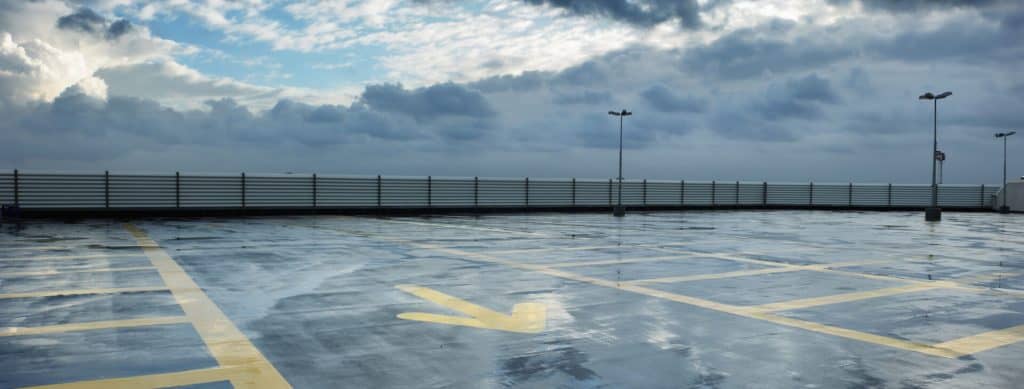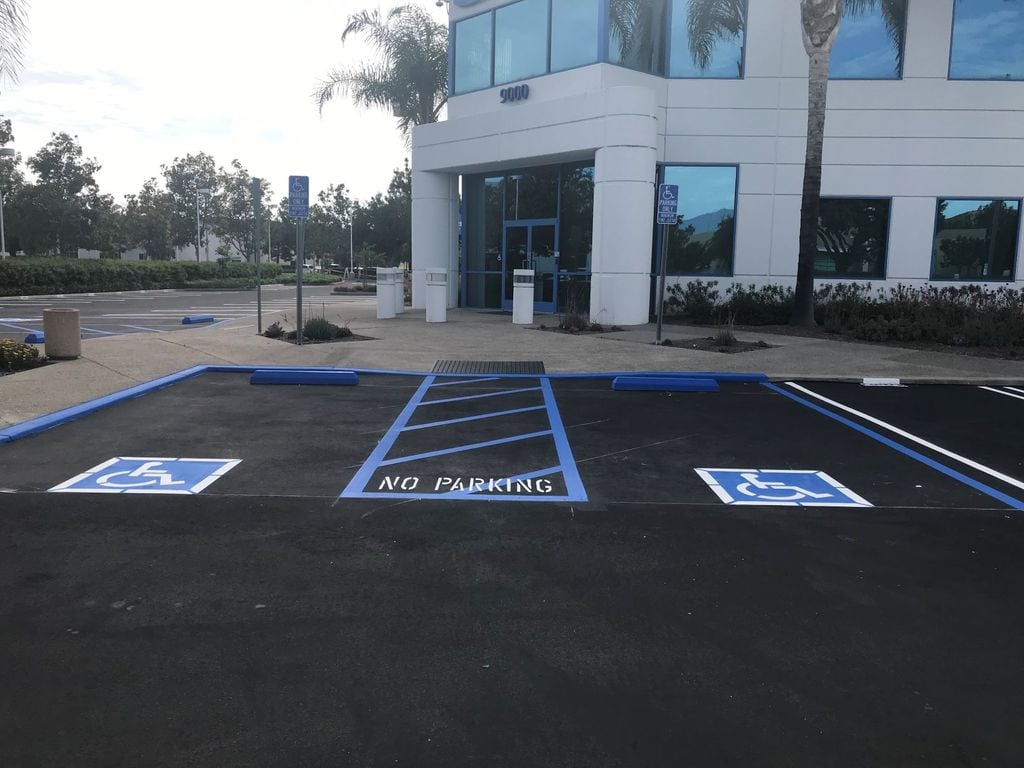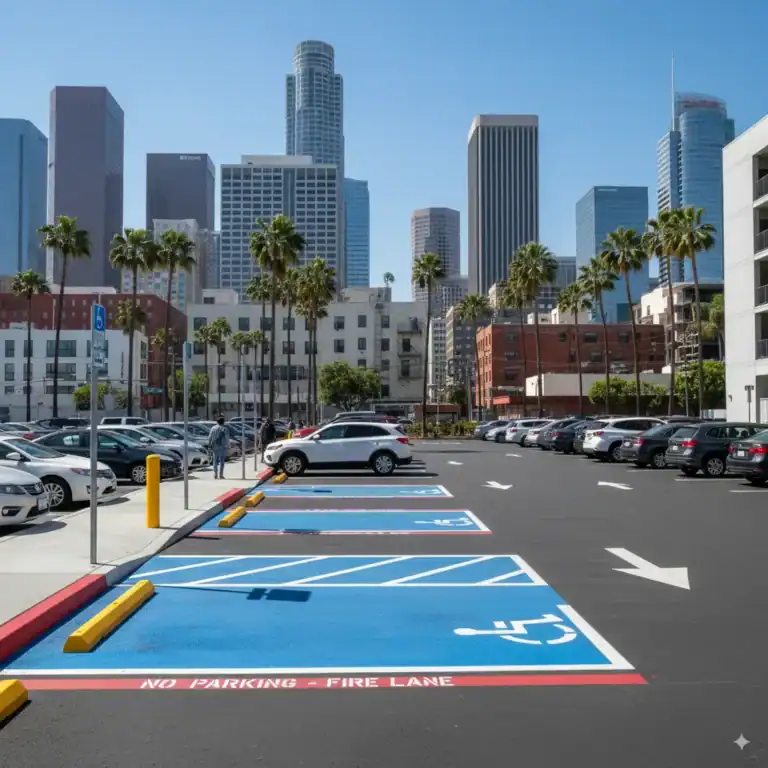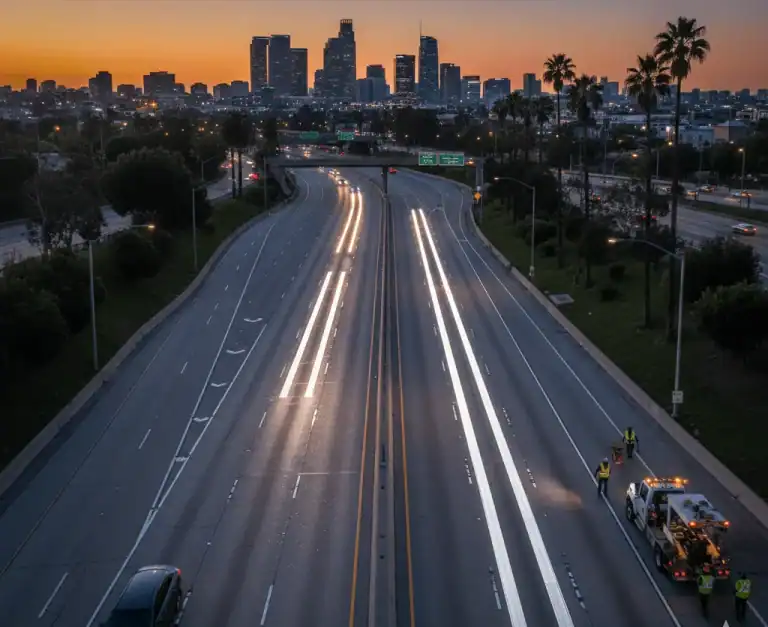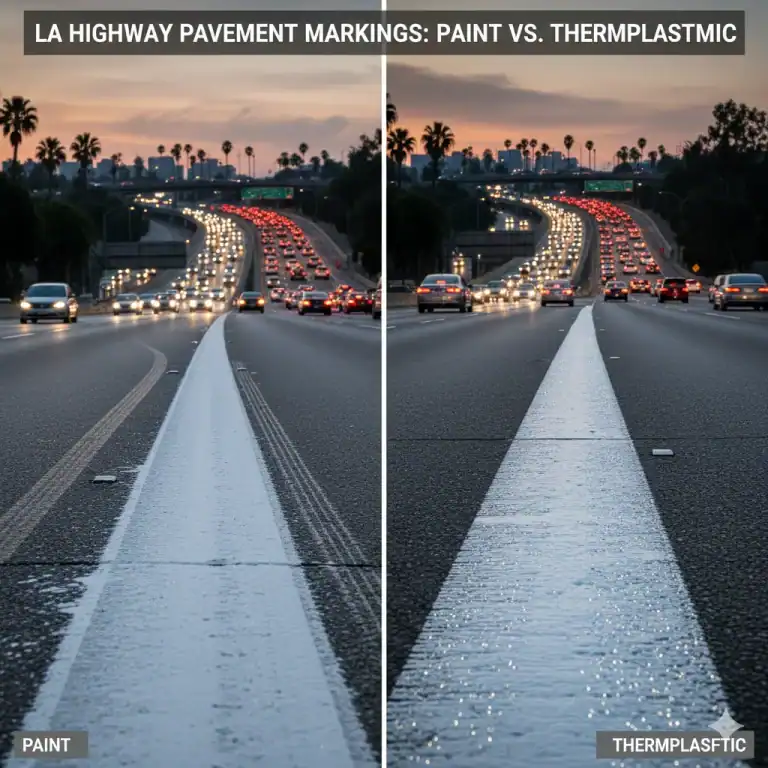What Is the Primary Purpose of Fresh Parking Lot Striping?
Fresh parking lot striping ensures vehicular and pedestrian safety, maintains ADA compliance, and minimizes legal risks.
Over time, ultraviolet (UV) exposure, rainfall, and traffic abrasion degrade painted lines. Faded markings reduce visibility, creating unsafe conditions and risking non compliance with the Americans with Disabilities Act (ADA).
What Are the Legal Consequences of Faded ADA Markings?
Businesses may be fined up to $10,000 for missing or non compliant accessible parking striping.
According to the U.S. Department of Justice, facilities that fail to provide properly marked accessible parking spaces violate Title III of the ADA. Inaccessible lots can lead to formal complaints, lawsuits, and federal or municipal penalties.
What Does ADA Compliant Parking Striping Require?
ADA compliant striping includes correct dimensions, colors, symbols, signage, and access aisle markings.
Federal ADA standards specify:
-
Width: At least 96 inches for accessible spaces
-
Access aisles: Minimum of 60 inches wide
-
Color: Blue background with a white International Symbol of Accessibility (ISA)
-
Signage: Vertical signs mounted at least 60 inches above ground level
Local regulations may require additional elements. Cities like Sarasota, Houston, Tampa, and Atlanta enforce municipal codes beyond federal standards. Always verify with local building departments.
What Type of Paint Should Be Used for Parking Lot Striping?
Only traffic grade water based or solvent based paints are approved for pavement marking.
Regular wall or interior paint does not adhere to asphalt and fades within weeks. In contrast:
-
Water based acrylic paint offers low VOC emissions and quick drying.
-
Solvent based paint provides durability in cold or wet conditions.
Adding reflective glass beads improves visibility during nighttime, rain, or snow. This feature is especially recommended for lots in snow prone or low light environments.
What Do Parking Lot Paint Colors Mean?
Each color serves a specific regulatory or directional function:
-
Blue: Accessible (ADA) parking
-
Yellow: Standard parking or caution zones
-
Red: Fire lanes or emergency no parking zones
-
White: Delineation of regular stalls or directional arrows
Understanding what yellow stripes in parking lots mean helps prevent misinterpretation and ensures compliance with local traffic codes.
How Frequently Should Parking Lot Lines Be Repainted?
Repainting is recommended every 12 to 18 months or immediately after sealcoating.
Two primary factors affect longevity:
-
Climate: Snowplows can remove painted lines; repainting is essential every spring in cold regions.
-
Traffic volume: High turnover lots (e.g., retail centers) experience faster wear and require more frequent repainting.
Sealcoating creates a black protective layer over asphalt but covers existing striping, necessitating complete restriping immediately after.
What Are the Rules for Handicap Parking Painting?
ADA regulations require specific space dimensions, access aisles, surface markings, and vertical signage.
For example:
-
Van accessible spaces must be 132 inches wide with a 60 inch aisle
-
Symbols must be white on a blue field
-
Signs must include the phrase “Van Accessible” where applicable
In cities such as Washington DC, Baton Rouge, Knoxville, and Indianapolis, enforcement officers inspect for conformance with both federal and local code. Noncompliance can lead to immediate citations.
What Are Common ADA Parking Terms People Search For?
These search phrases reflect the high demand for compliance services:
-
ADA parking striping near me
-
Handicap parking lot painting contractors
-
Accessible parking space dimensions
-
Reflective ADA compliant striping paint
-
ADA pavement marking guide
-
Accessible parking requirements for commercial properties
Property managers often search locally, e.g., “ADA parking striping company Atlanta”, to meet region specific codes.
Why Should Striping Follow Sealcoating?
Sealcoating covers all existing paint, requiring full restriping afterward for continued compliance and visibility.
Best practice dictates that restriping occur within 24 hours after sealcoating to ensure high visibility and surface adhesion. Skipping this step makes lots non compliant and increases the risk of ADA violations.
Is Line Striping a Scalable Maintenance Task?
Yes. Property managers can outsource striping to contractors or use commercial line striping machines.
Options include:
-
Push-behind stripers: Suitable for small lots
-
Self-propelled stripers: Used for medium to large-scale properties
-
Bead-dispensing stripers: Apply reflective beads automatically during painting
These machines are available with quick-dry and multi-color capabilities to meet ADA and local standards.
Final Guidelines for Parking Lot Striping and Compliance
To remain ADA-compliant and avoid fines, property managers should:
-
Repaint all parking lot lines every 12–18 months
-
Use only approved traffic paint and color codes
-
Install proper signage with minimum 60-inch height
-
Add reflective beads for night and weather visibility
-
Restripe immediately after any sealcoating process
-
Follow both federal and local ADA codes
Conclusion: Fresh Parking Lot Striping Is a Safety and Legal Requirement
Fresh parking lot striping is not optional it is a legal, functional, and safety critical requirement for all public access properties.
Failing to maintain visible and compliant markings can result in accidents, ADA violations, and costly fines. Property managers must repaint lines regularly, especially after sealcoating, and ensure that all handicap parking spaces meet federal and local accessibility standards. Using approved traffic paints, reflective beads, and proper signage ensures visibility, durability, and compliance year-round.
Maintaining updated striping is one of the simplest ways to meet regulatory requirements, reduce liability, and protect visitors. Regular inspections, adherence to ADA specifications, and use of expert contractors or professional equipment can help you meet both legal and operational expectations without disruption.


